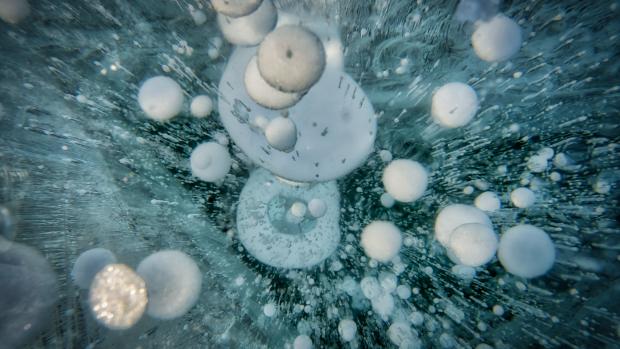As oceans warm will the methane "Kraken" be released?
Frozen hydrate crystals packed into tiny nanopores on ocean floors may hold the answer

Vast amounts of methane, which can warm the Earth 30 times more efficiently than CO2, are sequestered in oceans and lakes around the world.
A vast amount of the powerful greenhouse gas is sequestered as frozen crystals in the world’s oceans. Of great concern among experts is the growing risk that, as the Earth warms and ocean temperatures rise, these highly disruptive, potent greenhouse gases will ‘flee’ their frozen confinement.
To understand the stability of these crystalline hydrocarbon deposits, Ryan Hartman, associate professor of Chemical and Biomolecular Engineering at the NYU Tandon School of Engineering and Carolyn Koh of the Colorado School of Mines are launching an investigation into how this “fire ice” forms within a medium of sedimentary mineral deposits and remains in solid form under specific pressures and temperatures.
The work, "Kinetics of Gas Hydrate Crystallization and Dissociation in Tailored Confined Media" will focus on the structurally idiosyncratic formation of gas clathrate hydrates, the crystalline lattices of hydrogen-bonded water molecules that encapsulate small hydrocarbon (gas) molecules such as methane. The research is supported by a highly competitive, three-year, $975,000 grant from the U.S. Department of Energy - Office of Science.
Specifically, the new study, which extends research conducted earlier this year on marine bio-symbiosis influenced by and influencing frozen hydrates, explores gas hydrate crystallization in nanopores — pores or cavities in a substance whose dimensions can be measured at the nanometer scale. In oceans worldwide, hydrate crystals form within the nanopores of sedimentary materials from the arctic permafrost to a range of deep marine environments.
The heterogeneous materials have profound implications for energy and climate change, particularly in deeper waters, where these structures dominate: while they are vital, energy-rich entities that form spontaneously from water and small hydrophobic molecules under specific temperature and pressure conditions, they also keep highly volatile greenhouse gases under frozen “lock and key.”
He added that for gas hydrates within nanopores, this will be less of an issue. “This enhances their stability,” he said. “For instance, crystallization in the nanopores can change the melting point temperature and composition of frozen hydrates, and also the speed at which the gas is released from them, by comparison to bulk crystallizations, not involving nanopores.”
Hydrate formation is a nucleation and growth phenomenon; there is a critical crystal size beyond which thermodynamics favors growth over dissolution. While homogeneous nucleation of this critical size is possible in bulk water, it is known that heterogeneous nucleation — the formation of hydrate crystals within interstices of other mineral constituents — is a dominant process in natural and synthetic hydrates.
While the majority of hydrates have been found to crystallize in confined media (crystallization in confined spaces is an emerging area of inquiry), only a handful of investigations to date have studied the influence that porous materials have on hydrate crystallization.
The team aims to discover fundamental molecular-to-pore understanding of hydrate crystallization mechanisms in confinement, defined as crystallization constrained to: i) microscale gas-liquid or gas-liquid solid interfaces and ii) highly ordered, geometric nano- and micro-scale structured surfaces.
“We believe that the nature of the nanopores determines the gas hydrates nucleated in nanoconfinement, as well as their resultant molecular structure type and their crystallization and dissociation kinetics,” said Hartman.
Hartman and Koh will use microfluidic systems, a key area of inquiry and expertise for Hartman, to design highly ordered nanoporous structures to hone in on why nanopore geometry controls the nucleated hydrate characteristics, as well as to understand why these characteristics influence the resultant hydrate kinetics. The team also aims to determine the role confinement has on crystal growth beyond the nanopore exits. They will use machine learning, incorporating data from pore-scale discoveries from advanced experimentation to build first-principle models and generate design rules.
“We think this work will have a profound impact on the broader scientific community by discovering the mechanisms of hierarchical crystallizations in confinement and, more generally, of materials that can trap small molecules,” he added. “The research could also transform the way in which laboratory computations work in concert with advanced experimental methods for materials synthesis and manufacturing.”
The work will couple creative physical experimental synthesis and processing techniques, artificial intelligence methods, and in situ real-time monitoring tools for the measurement of high fidelity, transient information on confined crystallization and dissociation.




